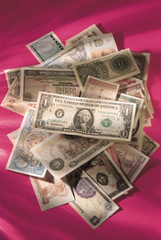
PREV ARTICLE
NEXT ARTICLE
FULL ISSUE
PREV FULL ISSUE
DIRTY MONEY: ALL BANK NOTES ARE TAINTED WITH BISPHENOL A
Here's a new twist on the dirty money theory.
-Editor
Now, you can add another statement of fact about paper currency. It is all contaminated with bisphenol A. That may not ring any immediate alarm bells but it should. BPA is recognised as an endocrine disruptor, and has been shown to cause reproductive problems and cancer in lab animals. It has also recently been linked to male infertility and may be an agent in several other diseases. So, it was a worrying development when two scientists based in the US discovered that every bank note that they examined had BPA on its surface. Kurunthachalam Kannan and Chunyang Liao from the Wadsworth Center, New York State Department of Health, and Department of Environmental Health Sciences at the State University of New York at Albany, examined the currency of 21 different countries with the same results. Total contamination. So, where does the BPA originate from? Its main source is industrial chemistry as a monomer for producing polycarbonate plastics which are used in the manufacture of plastic bottles, construction materials such as roofing, electronic components, computer discs and DVDs, among others. Small sections were removed from the bottom left and top right corners and the middle of each of the 51 notes with a hole punch and they were spiked with a deuterated BPA internal standard. The sections were extracted with methanol for analysis by LC/MS on a C18 column. BPA was eluted with an increasing flow of methanol in water for electrospray ionisation in negative-ion mode, followed by multiple reaction monitoring for BPA and the standard. The recovery was estimated at 105 ± 14.3% and the detection limit was 0.5 ng/g. All bank notes were contaminated with BPA at amounts ranging from 0.001-82.7 µg/g. In most cases, the BPA levels in the centres of the notes were higher than at the corners, with mean values of 6.26 ± 13.2 µg/g compared with 4.18 ± 9.93 and 4.37 ± 11.4 µg/g for the lower left and upper right corners. The levels in the corners might be lower because they are handled more often than the centres of the bank notes, encouraging transfer to the hands, but the research duo offered another explanation which was related to a proposed mechanism for currency contamination in the first place. It is known that cash register receipts produced on thermal paper have a thin coating of BPA. So, it is possible that BPA is transferred from a receipt to a bank note when the two are placed together in a wallet. The centres of the receipts and currencies are likely to be in contact the most. This theory was tested by placing seven bank notes from five countries next to thermal receipt paper for 24 hours in wallets before the currency was analysed for BPA as before. Notes with low initial levels of BPA displayed 100- to 1000-fold increases in concentration after contact, whereas those with high initial concentrations increased two-fold. So, this transfer mechanism does appear to be feasible. This was supported by the fact that the BPA levels on older bank notes were higher than on newer ones, the longer circulation periods allowing more time for transfer and accumulation.
To read the complete article, see:
Dirty money: All bank notes are tainted with bisphenol A
(www.separationsnow.com/coi/cda/detail.cda? The Numismatic Bibliomania Society is a non-profit organization promoting numismatic literature. See our web site at coinbooks.org. To submit items for publication in The E-Sylum, write to the Editor at this address: whomren@gmail.com To subscribe go to: https://my.binhost.com/lists/listinfo/esylum All Rights Reserved. NBS Home Page Contact the NBS webmaster 
|
